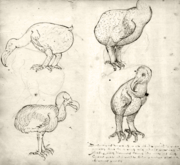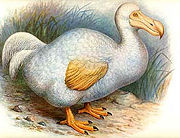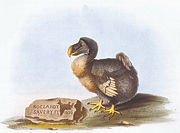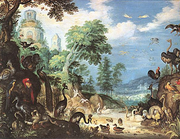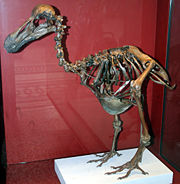Dodo
2008/9 Schools Wikipedia Selection. Related subjects: Birds
| Dodo Fossil range: Late Holocene |
||||||||||||||||
|---|---|---|---|---|---|---|---|---|---|---|---|---|---|---|---|---|
 Dodo reconstruction reflecting new research at Oxford University Museum of Natural History
|
||||||||||||||||
| Conservation status | ||||||||||||||||
| Scientific classification | ||||||||||||||||
|
||||||||||||||||
| Binomial name | ||||||||||||||||
| †Raphus cucullatus (Linnaeus, 1758) |
||||||||||||||||
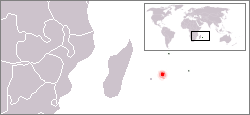 Former range (in red)
|
||||||||||||||||
| Synonyms | ||||||||||||||||
|
The dodo (Raphus cucullatus) was a flightless bird endemic to the Indian Ocean island of Mauritius. Related to pigeons and doves, it stood about a metre tall, weighing about 20 kilograms, living on fruit and nesting on the ground.
The dodo has been extinct since the mid-to-late 17th century. It is commonly used as the archetype of an extinct species because its extinction occurred during recorded human history, and was directly attributable to human activity. The adjective phrase "as dead as a dodo" means undoubtedly and unquestionably dead. The phrase "to go the way of the dodo" means to become extinct or obsolete, to fall out of common usage or practice, or to become a thing of the past.
Etymology
The etymology of the word dodo is not clear. However, there is a consensus that the name is probably pejorative. Some ascribe it to the Dutch word dodoor for "sluggard". It may be related to dodaers ("plump-arse"), the Dutch name of the Little Grebe. The connection may have been made because of similar feathers of the hind end or because both animals were ungainly. However, the Dutch are also known to have called the Mauritius bird the walghvogel ("loathsome bird" or "nauseating fowl") in reference to its taste. This last name was used for the first time in the journal of vice-admiral Wybrand van Warwijck who visited and named the island Mauritius in 1598. Dodo or Dodaerse is recorded in captain Willem van West-Zanen's journal four years later, but it is unclear whether he was the first one to use this name, because before the Dutch, the Portuguese had already visited the island in 1507, but did not settle permanently. The dodo was also known as the Devil's chicken to the early settlers of the island.
According to Encarta Dictionary and Chambers Dictionary of Etymology, "dodo" comes from Portuguese doudo (currently doido) meaning "fool" or "crazy". However, the present Portuguese name for the bird, dodô, is of English origin. The Portuguese word doudo or doido may itself be a loanword from Old English (cf. English "dolt").
Yet another possibility is that dodo was an onomatopoeic approximation of the bird's own call, a two-note pigeony sound like "doo-doo".
Systematics and evolution
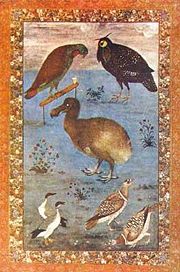
The dodo was a close relative of modern pigeons and doves. mtDNA cytochrome b and 12S rRNA sequences analysis suggests that the dodo's ancestors diverged from those of its closest known relative, the Rodrigues Solitaire (which is also extinct), around the Paleogene- Neogene boundary. As the Mascarenes are of volcanic origin and less than 10 million years old, both birds' ancestors remained most likely capable of flight for considerable time after their lineages' separation. The same study has been interpreted to show that the Southeast Asian Nicobar Pigeon is the closest living relative of the dodo and the Reunion Solitaire.
However, the proposed phylogeny is rather questionable as regards the relationships of other taxa and must therefore be considered hypothetical pending further research; considering biogeographical data, it is very likely to be erroneous. All that can be presently said with any certainty is that the ancestors of the didine birds were pigeons from Southeast Asia or the Wallacea, which agrees with the origin of most of the Mascarenes' birds. Whether the dodo and Rodrigues Solitaire were actually closest to the Nicobar Pigeon among the living birds, or whether they are closer to other groups of the same radiation such as Ducula, Treron or Goura pigeons is not clear at the moment.
For a long time, the dodo and the Rodrigues Solitaire (collectively termed "didines") were placed in a family of their own, the Raphidae. This was because their relationships to other groups of birds (such as rails) had yet to be resolved. As of recently, it appears more warranted to include the didines as a subfamily Raphinae in the Columbidae.
The supposed "White Dodo" is now thought to be based on misinterpreted reports of the Réunion Sacred Ibis and paintings of apparently albinistic dodos; a higher frequency of albinos is known to occur occasionally in island species (see also Lord Howe Swamphen).
Morphology and flightlessness
In October 2005, part of the Mare aux Songes, the most important site of dodo remains, was excavated by an international team of researchers. Many remains were found, including bones from birds of various stages of maturity, and several bones obviously belonging to the skeleton of one individual bird and preserved in natural position. These findings were made public in December 2005 in the Naturalis in Leiden. Before this, few associated dodo specimens were known, most of the material consisting of isolated and scattered bones. Dublin's Natural History Museum and the Oxford University Museum of Natural History, among others, have a specimen assembled from these disassociated remains. A Dodo egg is on display at the East London museum in South Africa. Until recently, the most intact remains, currently on display at the Oxford University Museum of Natural History, were one individual's partly skeletal foot and head which contain the only known soft tissue remains of the species.
The remains of the last known stuffed dodo had been kept in Oxford's Ashmolean Museum, but in the mid-18th century, the specimen – save the pieces remaining now – had entirely decayed and was ordered to be discarded by the museum's curator or director in or around 1755.
In June 2007, adventurers exploring a cave in Mauritius discovered the most complete and well-preserved dodo skeleton ever.
According to artists' renditions, the Dodo had greyish plumage, a 23-centimetre (9-inch) bill with a hooked point, very small wings, stout yellow legs, and a tuft of curly feathers high on its rear end. Dodos were very large birds, weighing about 23 kg (50 pounds). The sternum was insufficient to support flight; these ground-bound birds evolved to take advantage of an island ecosystem with no predators.
The traditional image of the dodo is of a fat, clumsy bird, hence the official scientific name Didus ineptus, but this view has been challenged in recent times. The general opinion of scientists today is that the old drawings showed overfed captive specimens. As Mauritius has marked dry and wet seasons, the dodo probably fattened itself on ripe fruits at the end of the wet season to live through the dry season when food was scarce; contemporary reports speak of the birds' "greedy" appetite. In captivity, with food readily available, the birds became overfed very easily.
Diet
The tambalacoque, also known as the "dodo tree", was hypothesized by Stanley Temple to have been eaten from by Dodos, and only by passing through the digestive tract of the dodo could the seeds germinate; he claimed that the tambalacocque was now nearly extinct due to the dodo's disappearance. He force-fed seventeen tambalacoque fruits to wild turkeys and three germinated. Temple did not try to germinate any seeds from control fruits not fed to turkeys so the effect of feeding fruits to turkeys was unclear. Temple also overlooked reports on tambalacoque seed germination by A. W. Hill in 1941 and H. C. King in 1946, who found the seeds germinated, albeit very rarely, without abrading.
Extinction
As with many animals evolving in isolation from significant predators, the dodo was entirely fearless of people, and this, in combination with its flightlessness, made it easy prey. But journals are full of reports regarding the bad taste and tough meat of the dodo, while other local species such as the Red Rail were praised for their taste. It is commonly believed that the Malay sailors held the bird in high regard and killed them only to make head dressings used in religious ceremonies. However, when humans first arrived on Mauritius, they also brought with them other animals that had not existed on the island before, including dogs, pigs, cats, rats, and Crab-eating Macaques, which plundered the dodo nests, while humans destroyed the forests where the birds made their homes; currently, the impact these animals – especially the pigs and macaques – had on the dodo population is considered to have been more severe than that of hunting. The 2005 expedition's finds are apparently of animals killed by a flash flood; such mass mortalities would have further jeopardized an already extinction-prone species.
Although there are scattered reports of mass killings of dodos for provisioning of ships, archaeological investigations have hitherto found scant evidence of human predation on these birds. Some bones of at least two dodos were found in caves at Baie du Cap which were used as shelters by fugitive slaves and convicts in the 17th century, but due to their isolation in high, broken terrain were not easily accessible to dodos naturally.
There is some controversy surrounding the extinction date of the dodo. Roberts & Solow state that "the extinction of the Dodo is commonly dated to the last confirmed sighting in 1662, reported by shipwrecked mariner Volkert Evertsz" (Evertszoon), but many other sources suggest the more conjectural date 1681. Roberts & Solow point out that because the sighting prior to 1662 was in 1638, the dodo was likely already very rare by the 1660s, and that thus a disputed report from 1674 cannot be dismissed out-of-hand. Statistical analysis of the hunting records of Issac Johannes Lamotius give a new estimated extinction date of 1693, with a 95% confidence interval of 1688 to 1715. Considering more circumstantial evidence such as travellers' reports and the lack of good reports after 1689, it is likely that the dodo became extinct before 1700; the last Dodo died little more than a century after the species' discovery in 1581.
Few took particular notice of the extinct bird. By the early 19th century it seemed altogether too strange a creature, and was believed by many to be a myth. With the discovery of the first batch of dodo bones in the Mare aux Songes and the reports written about them by George Clarke, government schoolmaster at Mahébourg, from 1865 on, interest in the bird was rekindled. In the same year in which Clarke started to publish his reports, the newly-vindicated bird was featured as a character in Lewis Carroll's Alice's Adventures in Wonderland. With the popularity of the book, the dodo became a well-known and easily recognizable icon of extinction.
Cultural significance
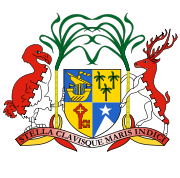
The dodo is used by many environmental organizations that promote the protection of endangered species, such as the Durrell Wildlife Conservation Trust and the Jersey Zoological Park, founded by Gerald Durrell.
The dodo's significance as one of the best-known extinct animals and its singular appearance has led to its use in literature and popular culture to symbolize a concept or object that will or has become out of date, expressed in the expression "dead as a dodo" or "gone the way of the dodo".
"Dodo" is also often used as a term to describe an unintelligent or deranged person, since the dodo had a reputation for an unintelligent lack of fear of humans.
The dodo rampant appears on the coat of arms of Mauritius.
